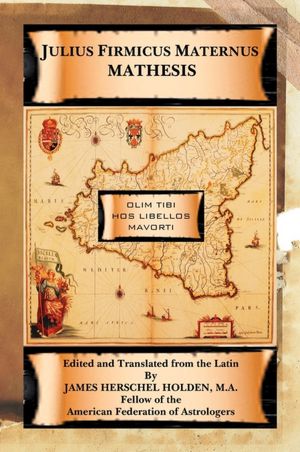
Julius Firmicus Maternus Junior V. C. (a VIP) was an attorney and Roman senator from Sicily. In his introduction, Firmicus explains that he has retired from his stressful legal practice and is writing this book at the request of his good friend Mavortius, a proconsul, during the Constantinian dynasty. The book was finished and sent to Mavortius around 354-355 CE.
Although Firmicus modestly deprecates his skills, he’s an orderly and thorough author with an exceptionally good grasp of the astrological techniques of his time. The book is divided into eight sections, an introduction and seven books “composed according to the order and number of the Seven Stars.”
“Mathesis” is in many respects a unique textbook. Other than the “Astronomica” of Manilius (an astrological poem that discusses the stories of the stars), this is the only astrology book written in Latin from this period. All the others were written in Greek. The Greek astrological jargon from his source material was Latinized. Furthermore, as Holden writes in the Translator’s Preface, “Much of the material in “Mathesis” is found nowhere else in the surviving classical literature, or, if it is found, it is not found in such detail. Hence, Firmicus’s Latin translations of the lost Greek originals are especially precious.” (pg xi) Only the “Astrological Compendium” of Rhetorius the Egyptian comes close to supplying the range of material contained in “Mathesis.”
The detailed delineations are astounding. Singular material includes valuable explanations about calculating and using dodecatemories and antiscia. Whole chapters of planetary combinations and Moon-aspect delineations provide a good idea of how sect was applied to chart interpretations. Moon aspect assessments include the effects of the waxing and waning Moon as she applies to conjunctions in diurnal and nocturnal charts. Delineations of planetary combinations explain personality traits and describe possible professions in which the native may be engaged.
Firmicus gives various techniques for identifying the Ruler of the Nativity and goes on to explain how each planet performs in this role. There’s also a section on the Ruler of the Times (similar to Time Lords or firdaria) and on Lots, which are associated with particular houses. In Book VII, Firmicus shifts to a topical format and describes the chart configurations one might expect to see in infant mortality, twins, slaves, animals, illnesses, death, marriage and types/number of spouses, fertility and sterility, nobility, sexual peculiarities (people of the late Empire period weren’t shy about getting their freak on), and a number of professions.
In the Translator’s Preface, Mr. Holden describes his lengthy involvement with “Mathesis,” which he started translating in 1955 and finally completed in 2006. He outlines his process of translation, the various problems of collating material from hand-copied manuscripts that still survive in European libraries, and his reasons for his editorial decisions (like word choice and chapter headings). He also supplies several appendices at the end of the book. Appendices 1 and 2 fill in gaps in the text with material from other books from the period. Appendices 3 to 8 are tables of fixed stars and paranatallonta, and indices of occupations, causes of death, personal characteristics, and people mentioned in the text with chapter and page numbers.
This is the second English translation of “Mathesis.” The first is by Jean Rhys Bram (1975). Holden’s translation benefits from his sixty years of experience as a translator and as an astrologer. This edition is targeted to astrologers; the footnotes clarify technical points and methods, or supply information about people and lifestyles of the ancient world mentioned in the text. With his encyclopedic knowledge of ancient astrological manuscripts, Mr. Holden also includes useful comparisons to other texts and ancient methods so the reader may better understand the ties between Firmicus and other ancient writers. The thirty surviving manuscripts of “Mathesis” are carefully perused and critiqued, and a suggested filiation (a family tree of these MSS) is offered, along with some notes about the journey of this book into modern times.
Since translations of ancient astrology books aren’t exactly popular best sellers, these books are run in small editions and are therefore correspondingly more expensive than comparable trade paperbacks of similar size and length. Astrology is a book-intensive field, and any practitioner worth his or her salt should (in my opinion) expect to invest in continuing education through magazines, books, and classes. Anyone who intends to make a serious study of ancient astrology should read “Mathesis” and the “Astrological Compendium” of Rhetorius the Egyptian (also translated by Holden, published by the American Federation of Astrologers [AFA], Inc., 2009). These two books hit all of the high points of thought and technique, and include material copied from books that didn’t survive the ages.
This is the longest and most detailed ancient astrology book I’ve ever read, and I highly recommend it as a selection for purchase for the meticulous thoroughness and breadth of Firmicus and the intelligence of Holden’s translation.
~review by Elizabeth Hazel
Author: Julius Firmicus Maternus
Translated and annotated by James Herschel Holden
AFA, Inc, 2011
pp. 578, $59.95
